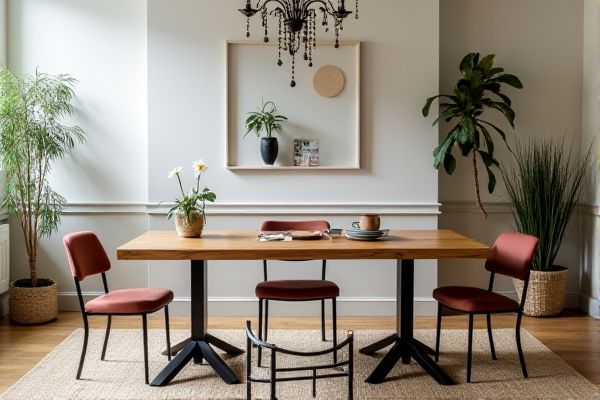
Parsons tables feature clean, straight legs positioned flush with the table edges, creating a minimalist and modern look, while trestle tables use two or more support beams connected by a stretcher for enhanced stability and a rustic charm. Discover the key differences, advantages, and best uses of each to choose the perfect table for your space by reading the rest of the article.
Table of Comparison
| Feature | Parsons Table | Trestle Table |
|---|---|---|
| Design | Minimalist, straight lines, seamless edges | Two trestle supports with a removable top |
| Structure | Boxy, solid legs integrated with the tabletop | Independent legs/brackets supporting the tabletop |
| Material | Wood, MDF, laminate, often painted | Solid wood, metal, or a combination |
| Functionality | Stable, fixed structure, ideal for dining/study | Portable and collapsible, good for flexible spaces |
| Aesthetic | Modern, sleek, versatile | Rustic, traditional, or industrial |
| Assembly | Usually fixed, minimal assembly required | Easy to assemble/disassemble |
| Space Efficiency | Compact footprint, offers legroom | Allows easy storage when disassembled |
Parsons Table vs Trestle Table: An Overview
Parsons tables feature clean, straight lines with legs flush at the corners, creating a minimalist and modern aesthetic ideal for contemporary spaces. Trestle tables are supported by two or more trestle-style legs connected by a horizontal beam, offering sturdy construction and a traditional, rustic appeal perfect for larger dining areas. Understanding these key differences helps you choose a table style that complements your interior design and functional needs.
Defining the Parsons Table
The Parsons table features clean, straight lines with legs positioned flush with the tabletop edges, creating a minimalist and versatile design. Originating in the 1930s, this table emphasizes simplicity and functionality, often crafted from wood, metal, or glass. Its compact structure makes it ideal for modern interiors requiring unobtrusive furniture with a sleek aesthetic.
Understanding the Trestle Table
The trestle table features a sturdy design with two or more fixed legs connected by a horizontal beam, providing strong support and easy assembly. Its open base allows for flexible seating arrangements and ample legroom, making it ideal for dining or workspace environments. Understanding the trestle table helps you choose a versatile piece that balances durability and style in your home.
Key Design Differences
Parsons tables feature a minimalist design with straight, square legs positioned at the corners, creating a clean, boxy silhouette ideal for modern interiors. Trestle tables are defined by a central support beam connected to two or more legs or trestles, offering enhanced stability and a more traditional or rustic aesthetic. The key design difference lies in leg placement and structural support, with Parsons tables emphasizing simplicity and trestle tables focusing on robust, functional frameworks.
Material Choices and Construction
Parsons tables often feature minimalist designs with materials like lacquered wood, metal, or glass, emphasizing clean lines and a seamless surface. Trestle tables are traditionally constructed from solid wood such as oak, pine, or walnut, featuring a robust base with two or more trestle supports connected by a stretcher for stability. Your choice between these tables depends on whether you prefer the modern simplicity and varied materials of a Parsons table or the sturdy, classic wood construction of a trestle table.
Style and Aesthetic Appeal
Parsons tables showcase a sleek, minimalist design characterized by clean, straight lines and a uniform thickness from top to legs, making them ideal for modern and contemporary interiors. Trestle tables exude rustic charm with their exposed support beams and often intricate leg designs, lending a traditional or farmhouse aesthetic to a space. The Parsons table's streamlined silhouette contrasts with the trestle table's structural emphasis, offering distinct style choices that cater to different decorative themes.
Functionality and Versatility
Parsons tables feature clean, straight legs positioned at the corners, offering sleek design and adaptability for various settings such as dining, workspaces, or display surfaces. Trestle tables consist of two or more supports connected by a central beam, providing sturdy construction ideal for larger gatherings and easy disassembly for portability. Both types excel in functionality, but Parsons tables prioritize minimalist style and versatility, while trestle tables emphasize robust support and flexibility in accommodating extended tabletops.
Space Efficiency and Placement
Parsons tables feature a compact, minimalistic design with straight legs that align flush with the tabletop edges, making them ideal for tight spaces and easy placement against walls or in corners. Trestle tables, supported by two sturdy legs connected by a central beam, offer more legroom and flexibility in seating arrangements but require more floor space due to their bulkier base. Your choice depends on prioritizing space efficiency for smaller rooms with a Parsons table or opting for a trestle table to accommodate gatherings in larger, open areas.
Durability and Maintenance
Parsons tables feature a solid construction with four squared legs at the corners, offering excellent durability and stability suitable for heavy daily use. Trestle tables rely on a central support beam and two legs or pedestals, which can sometimes be less stable but allow easier maintenance and cleaning underneath. Both table types typically use hardwoods like oak or maple, but Parsons tables often require less frequent tightening of joints, making them lower maintenance over time.
Choosing the Right Table for Your Space
Parsons tables offer a sleek, minimalist design with straight, squared legs that fit well in modern, compact spaces, making them ideal for small dining areas or offices. Trestle tables feature sturdy, wide supports that provide strong stability and ample legroom, perfect for larger rooms or communal dining setups. Selecting between Parsons and trestle tables depends on your spatial constraints, desired aesthetic, and functional needs, with Parsons suited for streamlined environments and trestle better for spacious, traditional settings.
 homyna.com
homyna.com